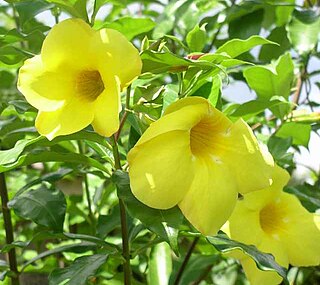
Allamanda cathartica, commonly called golden trumpet, common trumpetvine, and yellow allamanda, is a species of flowering plant of the genus Allamanda in the family Apocynaceae. It is native to Brazil. This plant is cited in Flora Brasiliensis by Carl Friedrich Philipp von Martius.
Gonatogyne is a genus of plants in the family Phyllanthaceae first described as a genus in 1873. It contains only one known species, Gonatogyne brasiliensis, endemic to southeastern Brazil.
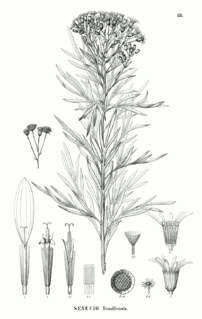
Flora Brasiliensis is a book published between 1840 and 1906 by the editors Carl Friedrich Philipp von Martius, August Wilhelm Eichler, Ignatz Urban and many others. It contains taxonomic treatments of 22,767 species, mostly Brazilian angiosperms.
Hygrophila costata, with the common names glush weed, gulf swampweed, and yerba de hicotea, is an aquatic plant
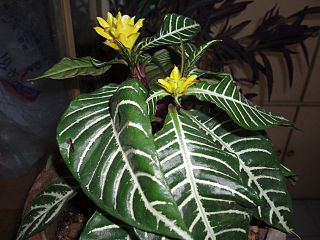
Aphelandra squarrosa is a plant species in the family Acanthaceae, which is native to Atlantic Forest vegetation of Brazil. This plant is often used as a house plant. This plant is cited in Flora Brasiliensis by Carl Friedrich Philipp von Martius.
Aphelandra stephanophysa is a plant species in the family Acanthaceae, which is native to Atlantic Forest vegetation of Brazil. This plant is cited in Flora Brasiliensis by Carl Friedrich Philipp von Martius.
Allamanda puberula is a species of plant in the family Apocynaceae, which is native to Brazil, typically in Caatinga, and Cerrado vegetation. This plant is cited in Flora Brasiliensis by Carl Friedrich Philipp von Martius.
Aegiphila mollis is a species of flowering plant in the family Lamiaceae. It is native to Central and South America. Its common names include contra culebra and totumillo.
Aegiphila sellowiana is a species of tree or shrub in the family Lamiaceae. It is native to Bolivia, Brazil, and Ecuador. Its common names include tamanqueira.

Anemopaegma glaucum is a plant native to Caatinga and Cerrado vegetation in Brazil. This plant is cited in Flora Brasiliensis by Carl Friedrich Philipp von Martius.

Asteranthos is a genus of woody plant in the family Lecythidaceae. There is only one known species, Asteranthos brasiliensis, native to Venezuela and Brazil.
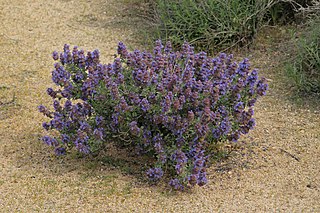
Salvia dorrii, the purple sage, Dorr's sage, fleshy sage, mint sage, or tobacco sage, is a perennial spreading shrub in the family Lamiaceae. It is native to mountain areas in the western United States and northwestern Arizona, found mainly in the Great Basin and southward to the Mojave Desert, growing in dry, well draining soils.

Labdane is a natural bicyclic diterpene. It forms the structural core for a wide variety of natural products collectively known as labdanes or labdane diterpenes. The labdanes were so named because the first members of the class were originally obtained from labdanum, a resin derived from the gum rockrose.

Salvia candelabrum is a species of flowering plant in the family Lamiaceae, native to Spain. It is a woody-based perennial growing to 100 cm (39 in), with woolly grey-green leaves that resemble those of the common sage, S. officinalis, and emit a similar scent when crushed. In summer it bears violet-blue flowers on branching stems held high above the foliage.

The Euphorbiaceae, the spurge family, are a large family of flowering plants. In common English, they are sometimes called euphorbias, which is also the name of a genus in the family. Most spurges such as Euphorbia paralias are herbs, but some, especially in the tropics, are shrubs or trees, such as Hevea brasiliensis. Some, such as Euphorbia canariensis, are succulent and resemble cacti because of convergent evolution. This family occurs mainly in the tropics, with the majority of the species in the Indo-Malayan region and tropical America a strong second. A large variety occurs in tropical Africa, but they are not as abundant or varied as in the two other tropical regions. However, the Euphorbiaceae also have many species in nontropical areas such as the Mediterranean Basin, the Middle East, South Africa, and the Southern United States.
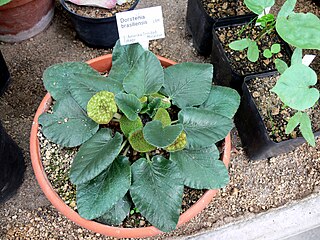
Dorstenia brasiliensis is a species of herbaceous plant in the family Moraceae of the order Rosales.
Dodonaea petiolaris is a shrub species in the genus Dodonaea found in Australia.

Taxodone is a naturally occurring diterpenoid found in Taxodium distichum, Rosmarinus officinalis (Rosemary), several Salvia species and other plants, along with its oxidized rearrangement product, taxodione. Taxodone and taxodione exhibit anticancer, antibacterial, antioxidant, antifungal, insecticide, and antifeedant activities.
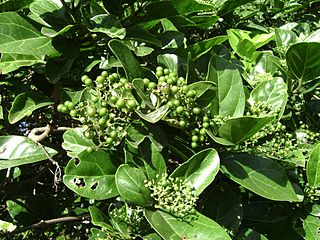
Premna serratifolia is a small tree/shrub in the family Lamiaceae. It flowers and fruits between May and November. During flowering season, it attracts a large number of butterflies and bees. Synonyms of Premna serratifolia Linn. include P. corymbosa Merr., P. integrifolia L. and P. obtusifolia R. Br.).
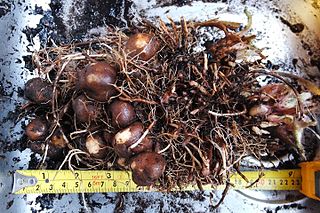
Phlomoides tuberosa is a perennial flowering plant in the family Lamiaceae native to China, Kazakhstan, Kyrgyzstan, Mongolia, Russia; SW Asia and Europe. Enlarged, tuberous roots give rise to erect stems to 150 cm bearing purple-red flowers.












